This column, from the weekly opinion piece MATTER OF FACT, first appeared in the Home Reporter and Spectator dated November 7, 2019
In addition to being the last day of New York’s first-ever round of early voting, this past Sunday also marked one year until the 2020 election. High profile races will be on the ballot next year, from state senators to assembly members to congressional reps, but obviously none more important than the office of the presidency.
Whichever candidate you select for a seat in the legislatures in Albany and Washington in 2020, whoever receives the most votes will be the winner. Thanks to the Electoral College, that won’t necessarily be the case for the highest office in the land.
The 2016 presidential election went to the candidate with nearly 3 million fewer votes, but that was not an aberration. Two of the past five presidential elections have gone to the person with less votes, meaning that since 2000, 40 percent of the time, the winner has been the candidate who in any other race, anywhere else in the world, would be the loser. In that same span of time, only one President’s tenure in the White House began after actually receiving the most votes.

At the time the Electoral College was written into the constitution in 1787, the largest state had about 19 times the population of the smallest state. Today, the most populous state is 66 times the size of the smallest, a disparity the framers of the Constitution surely did not anticipate.
And of the nearly 750,000 people that made Virginia the most populous state in 1787, 4 in 10 of them were enslaved, which brings us to the primary reason we wound up with the Electoral College: the three-fifths compromise.
There were several reasons the Constitution didn’t simply use the national popular vote to decide who wins the presidential election, and different factions had different motivations for resisting that straight-forward method, but the biggest impediment, by far, was the southern slaveholding states.
Some say that eliminating the electoral college would give less importance to smaller states, but quite simply, it would give all Americans equality in terms of the weight of their vote.
The decennial Census that the Constitution requires ultimately determines the number of electoral votes states receive. Southern states wanted to include their entire slave population for apportionment, while anti-slavery delegates wanted only free persons counted. The “peculiar institution” of slavery, as Lincoln would refer to it, created the peculiar mathematical compromise of counting only three-fifths of persons held as property with no rights.
Slavery and the direct electoral ramifications of it were amended out of the Constitution over 150 years ago, but the electoral college system our nation’s original sin fomented is still the method we use to select our leader. But, in a democracy, where a foundational principle is ‘one person, one vote,’ it is undemocratic to give people voting in Wyoming far greater influence because their state has fewer people.
Some say that eliminating the Electoral College would give less importance to smaller states, but quite simply, it would give all Americans equality in terms of the weight of their vote. Some say using the popular vote would mean candidates would no longer pay attention to rural areas, but the combined population of the nation’s 50 largest cities only accounts for 15 percent of all Americans.
In our current system, candidates spend an inordinate amount of attention on a few battleground states, where other states that go overwhelmingly for one party or the other are ignored. Conservatives in New York feel that their vote for president does not matter because in the Electoral College’s winner-takes-all format, Republican candidates with no opportunity to win any electoral votes in our state ignore it completely.

Longtime Brooklyn Rep. Emanuel Celler shepherded a resolution through the House in 1969 to amend the Constitution to use the popular vote to determine the result of presidential elections, and although a majority of the Senate favored it, it didn’t reach the necessary two-thirds threshold and died. It is unlikely those benefitting from the status quo would be in favor of moving to a true ‘one person, one vote’ system.
Everybody’s vote should matter. Everybody’s vote should count equally, regardless of their party or where they live. Unfortunately, that is not where we find ourselves, which is why we all must make the most of our votes, even if they may count for less here in New York.




